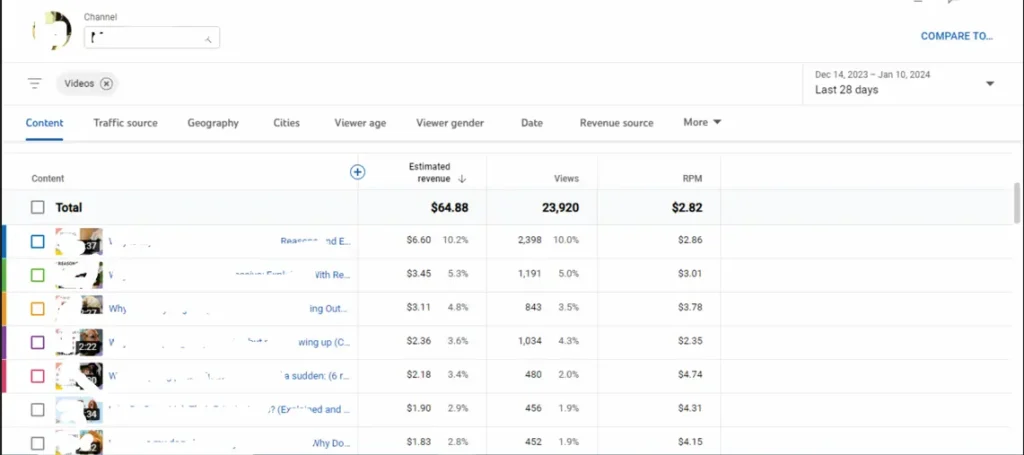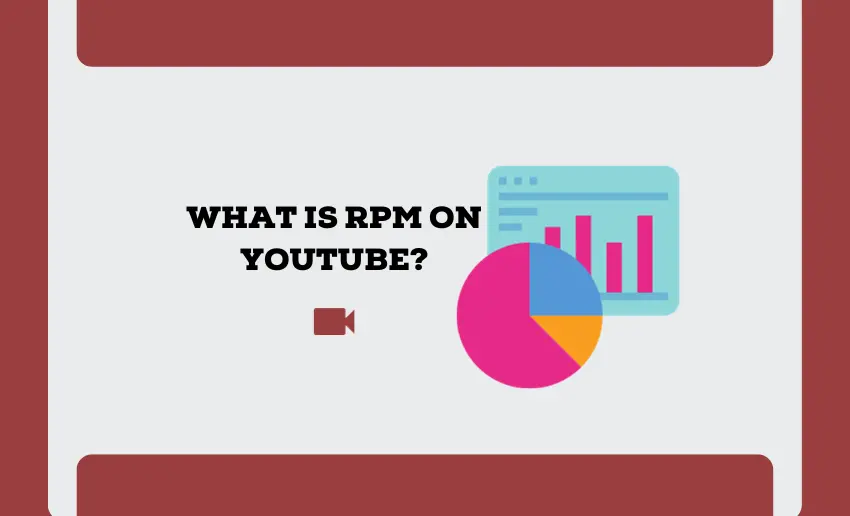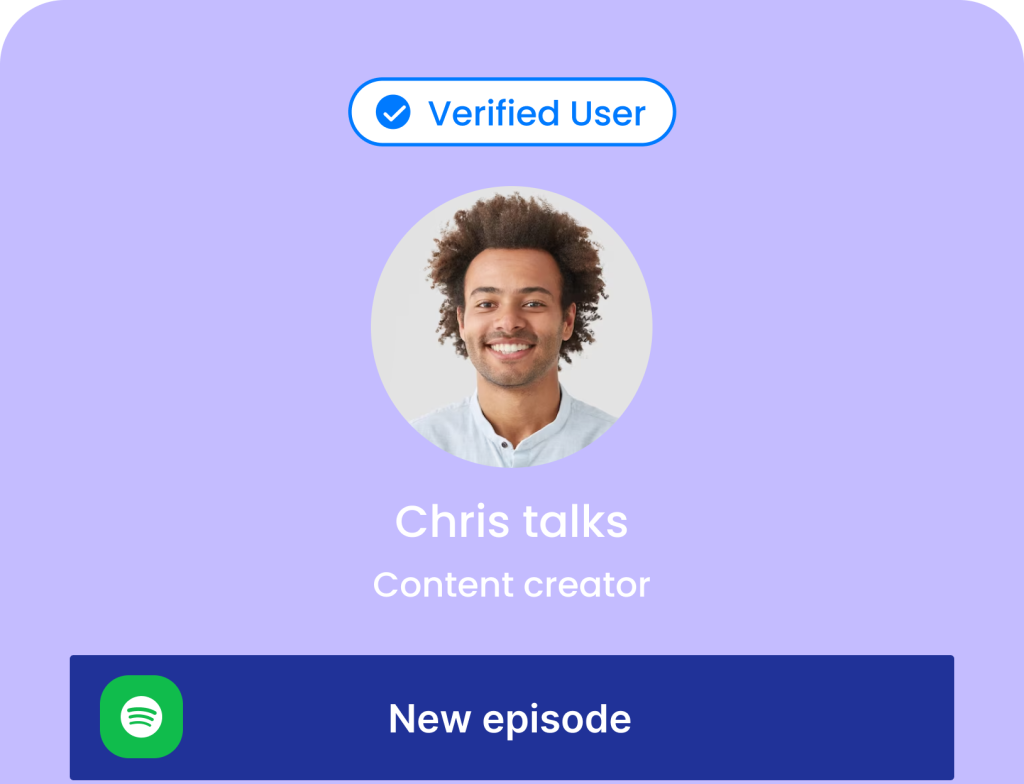Every creator’s dream on YouTube is to make money off the platform. However, understanding how money is made on YouTube is super important. One big deal is RPM (Revenue Per Mille); it’s a bit mysterious but has a huge impact. This has made many wonder about RPM YouTube meaning over the years.
What is the meaning of RPM on YouTube? And why should you care?
This article takes you on a journey to uncover why RPM matters, what it’s made of, and why it’s vital for creators. As things change online, knowing RPM isn’t just interesting; it’s a must-know for anyone wanting to succeed in making money on YouTube.
What is RPM on YouTube?
RPM on YouTube stands for “Revenue Per Mille,” where “mille” refers to a thousand. It represents the estimated earnings a content creator generates for every thousand views on their videos after YouTube’s revenue share.
RPM shows how much cash you make for every 1,000 views on your videos. It adds money from ads, memberships, YouTube Premium, Super Chat, and Super Stickers. RPM is the big picture of your earnings after YouTube gets its share.
How is YouTube RPM calculated?
RPM reflects what you earn from your content. For instance, if YouTube applies a 60/40 ad revenue split, you get 40% of the revenue, and YouTube takes the rest. The 40% represents part of your RPM. The same applies to all other revenue means as YouTube retains its share.
Manually figuring out your RPM is quite simple. Divide the money you earned in a timeframe by the total number of views you got, then multiply that result by 1,000. Here’s an easy formula for you:
RPM = (Total Views/Total Revenue) × 1000
While RPM focuses on revenue within YouTube’s platform, creators can expand their earnings by exploring sales outside this ecosystem, thus retaining a larger portion of their revenue.
How to locate your YouTube RPM

Like other metrics, you can locate your RPM within your YouTube Studio. Follow these steps:
- Navigate to YouTube Studio;
- Click on Analytics from the menu on the left;
- Open the Revenue tab in the top navigation bar;
- Select “See More”
- Choose the RPM option from the drop-down menu;
- Review your overall RPM for a chosen date range.
Is RPM the same as CPM on YouTube?
RPM (Revenue Per Mille) and CPM (Cost Per Mille) are related but not the same on YouTube.
The CPM metric represents the cost an advertiser pays for a thousand views of their ad on a video. It’s calculated based on the advertiser’s spending and reflects the creator’s estimated earnings per thousand views before YouTube’s share.
On the other hand, RPM reflects the creator’s actual earnings per thousand views after YouTube deducts its share from the ad revenue. It encompasses various revenue sources like ads, memberships, Super Chats, and more, providing a comprehensive view of the creator’s earnings.
So, while CPM is the advertiser’s cost per thousand views, RPM is the creator’s earnings per thousand views after YouTube’s deductions, making them distinct metrics within the YouTube monetization ecosystem.
Why RPM matters on YouTube
Now that you know what RPM is, why exactly does it matter? RPM is vital for creators turning their channels into businesses. Here are a few reasons you should pay attention to your YouTube RPM:
1. Financial clarity for creators
After YouTube’s deductions, RPM provides a clear picture of actual earnings per thousand views. Understanding RPM helps creators gauge their channel’s financial performance accurately, guiding decisions on content strategies, investments, and business expansion crucial for sustainable growth.
2. Performance evaluation metric
As a comprehensive metric encompassing various revenue sources, RPM is a benchmark for evaluating content performance. It enables creators to assess which videos or content types generate higher revenue, aiding in refining future content strategies for increased profitability.
3. Strategic revenue optimization
RPM guides creators in optimizing their revenue generation strategies. By analyzing RPM fluctuations, creators can identify factors impacting earnings, such as content types, ad placements, or engagement tactics. This insight allows adjustments to maximize revenue potential, which is crucial for long-term success.
4. Channel monetization assessment
RPM serves as a critical metric for creators aiming to monetize their channels effectively. It assists in understanding the channel’s earning potential, setting realistic revenue goals, and aligning content strategies with revenue expectations for sustainable growth.
5. Business decision-making tool
RPM’s insights extend beyond content creation; they influence broader business decisions. Creators leveraging YouTube as a business platform rely on RPM to comprehend earnings, forecast revenue, and make informed decisions regarding resource allocation, partnerships, or product development.
5 Factors contributing to RPM
1. CPM (Cost per Mille)
CPM, or Cost Per Mille, represents the money advertisers pay for a thousand views of their ads on your videos. It’s a significant factor in your RPM, directly influencing your earnings. Creating content that attracts higher-paying ads can increase your CPM, leading to a higher RPM.
2. Fill rate
Fill rate indicates the percentage of times ads are displayed compared to the number of times they could be shown. A higher fill rate means more ads displayed, potentially boosting your earnings. Factors like video content, viewer demographics, and seasonality impact the fill rate.
3. Monetized playbacks
Monetized playbacks refer to the number of times ads are shown on your videos. YouTube doesn’t place ads on every view for various reasons, such as content suitability or viewer location. Maximizing monetized playbacks involves creating content that aligns with YouTube’s advertiser-friendly guidelines.
4. Content sensitivity
Content sensitivity refers to the nature of your content and its alignment with advertiser preferences. Edgy or controversial content may get demonetized, negatively affecting CPM and RPM. Balancing engaging content and advertiser-friendly material ensures consistent monetization and a healthy RPM.
5. Niche and Advertisers
Different niches attract varying levels of advertisers willing to pay for ad placements. Niche content that aligns with high-paying advertisers tends to yield a higher CPM and, subsequently, a higher RPM.
What is a good RPM on YouTube?
A “good” RPM on YouTube is typically considered higher than average for your content category or niche. Some creators aim for RPMs above $1 to $4, which can significantly differ based on various factors. Generally, RPMs can range from a few cents to several dollars per thousand views. However, a “good” RPM can vary widely based on several factors, including the content niche, audience demographics, and the type of ads displayed.
Ways to optimize RPM for growth on YouTube
Boosting RPM involves blending content strategy, sales tactics, and understanding your audience. It’s not just about views; it’s about maximizing revenue from each interaction. Here are a few ways you can improve your RPM on YouTube:
1. Audience targeting and content optimization
Understanding your audience’s preferences helps tailor content that attracts higher-paying advertisers. Creating content aligned with audience interests increases engagement, boosting ad views. This targeted approach enhances the likelihood of ads relevant to your audience, improving RPM as advertisers value more engaged viewers.
2. Diversification of revenue streams
Exploring additional revenue avenues beyond ads, such as merchandising, memberships, super chats, and super stickers, diversifies income. This strategy reduces dependency on ad revenue alone, allowing creators to earn more, ultimately contributing to a higher RPM.
3. Ad placement strategy
Strategic ad placements within videos impact viewer interaction and, consequently, RPM. Placing ads at natural breaks or engaging moments rather than disrupting the viewer experience can increase ad views. This enhances RPM by optimizing ad visibility and viewer interaction.
4. Focus on high-CPM content
Creating content that appeals to high-paying advertisers increases CPM, positively impacting RPM. Content sensitive to advertisers’ preferences and aligned with niche interests often attracts more lucrative ads, elevating earnings per thousand views and boosting RPM.
5. Engagement for Super Chats and Donations
Encouraging audience engagement through live streams or Q&A sessions can drive super chats and donations. These interactions within YouTube’s ecosystem contribute to RPM by adding to the overall revenue generated per view, positively impacting creators’ earnings.
6. Optimization of video length and frequency
Balancing video length and frequency impacts viewer retention and ad views. Longer videos may contain more ads, but risk reduced viewer retention, affecting ad completion rates. Striking a balance between video length and ad placement optimizes RPM by maintaining viewer engagement and ad views.
7. Constant performance evaluation and adaptation
Regularly analyzing RPM trends and performance metrics helps identify successful strategies. Adapting content, engagement tactics, or revenue sources based on this evaluation fosters continual improvement, which is crucial for sustained growth in RPM and overall channel earnings.
In the End
RPM, or Revenue Per Mille, is a critical metric for YouTube creators, offering a comprehensive view of earnings per thousand views after deductions. It’s more than a number; it reflects a creator’s financial performance, guiding decisions and strategies for sustainable growth in the YouTube ecosystem. By leveraging RPM insights, optimizing content strategies, and exploring diversified revenue streams, creators can harness the full potential of their channels, ensuring sustainable growth and financial success on YouTube.








